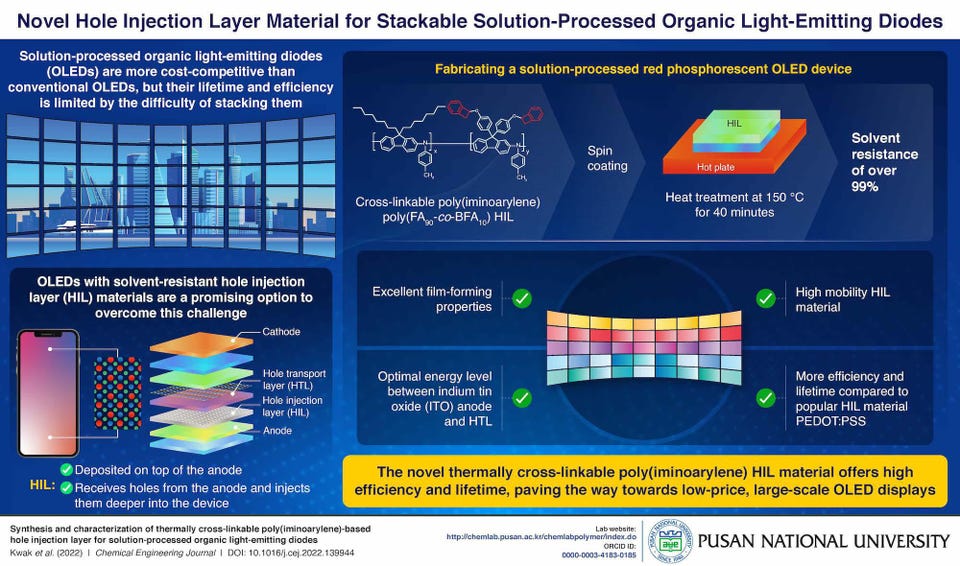New OLED Breakthrough Could Lead To Much Cheaper TVs And Mobile Phones

Much as serious home entertainment fans might love OLED TVs, most will surely wish they didn’t have to pay so much to buy one. While prices have slowly come down over recent years, to a point, in fact, where many OLED TVs can be considered good value for the quality they offer, the fact remains that even the cheapest OLED TV models still carry premium price tags compared with the majority of the LCD TV world.
This barrier to OLED entry might soon be overcome, though, thanks to a new breakthrough in OLED manufacturing developed by researchers at South Korea’s Pusan National University. Led by Professor Do-Hoon Hwang, who has been conducting research on organic semiconductor materials and electronic device applications for more than two decades, a team of scientists at the university have found a way to use cost-effective solution-processed organic light emitting diodes that overcomes the usual problems associated with stacking the composite layers in this approach to manufacturing OLED screens. Problems which have until now caused lifetime and efficiency issues that have prevented the solution-processed approach from becoming commercially viable.

The new solvent-resistant hole injection layer material (a thermally cross-linkable poly(iminoarylene) for the scientists among you!) developed by Professor Hwang and his colleagues also provides supposedly excellent film-forming properties, optimum energy and high mobility – adding up to a development that the university believes represents “a major stepping stone toward commercial viability of solution-processed OLEDs.”
The solution-processed OLED approach can, the Pusan National University researchers claim, run at large scale fabrication levels much more easily and affordably than the current notoriously cost and labor intensive approach to making OLED displays. And it appears that there are no major issues with scaling the new technology to different screen sizes either, with the University’s announcement on its break through stating that as well as TVs, solution-processed OLEDs have the potential to transform the mobile phone and camera markets, too.
The Pusan National University research team first presented technical details of its OLED breakthrough in a paper published online on October 22 2022, before getting the paper published (Volume 454, Part 1, Article number 139944) in the Chemical Engineering Journal on 15 February 2023. This paper discusses in depth why the University’s development has so much potential, starting with the fact that solution-processed OLEDs have struggled to achieve the sort of efficiencies and lifespans required for commercialisation due to the difficulties associated with stacking constituent display layers, such as the anode, cathode, hole injection layer (HIL), hole transport layer (HTL) and so on top of each other accurately enough to construct an effective finished LED.
Professor Hwang goes on to explain that while many HTL materials have been developed already, research on the HIL has been much more limited. The material the professor and his colleagues have developed, however, enjoys more than 99% resistance to solvents and has an energy level that’s a perfect intermediate between that of the indium tin oxide electrodes and the HTL, as well as enjoying high mobility and strong film-forming properties – all of which are critical for making a new generation of commercially produced, potentially significantly cheaper OLED screens possible.
There’s no word in the university’s announcement to the press on a potential time frame for seeing its new stackable hole injection layer material material being adopted for widespread manufacturing, and it’s not clear (to me, anyway!) how easy it might be to adapt the current huge ‘traditional’ OLED manufacturing facilities around the world to the new solution-processed approach.
Nor am I qualified enough to say whether even the improved solution-processed approach still needs further refinement before cheaper OLED TVs and phone screens that use it are really ready to roll out to consumers.
Along with the new Micro Lens Array (MLA) technology that’s about to revolutionise the performance of OLED TVs, though, Pusan National University’s work further suggests that contrary to what we were starting to think a couple of years ago, there’s plenty of hardware advancement life left in the old OLED display yet.
